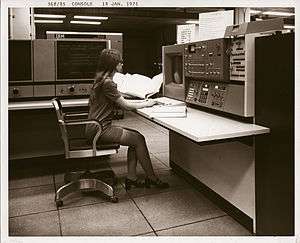IBM System/360 Model 85
The IBM System/360 Model 85 is a high-end member of the System/360 family of computers, with many advanced features, and was announced in January 1968 and first shipped in December 1969.[1] IBM built only about 30 360/85 systems[1][2] because of "a recession in progress".[3]
 | |
 IBM System/360 Model 85. View of system console. The left side has a Microfiche Document Viewer | |
| Manufacturer | International Business Machines Corporation (IBM) |
|---|---|
| Product family | System/360 |
| Memory | 512 K - 4 M Core |
Models
The four models of the 360/85[4] are: I85 (512K), J85 (1M), K85 (2M) and L85 (4M), configured with 2 2365 Processor Storage units, 4 2365 units, an IBM 2385 Processor Storage unit Model 1 (=2M), or an IBM 2385 Processor Storage unit Model 2 (=4M) respectively. The I85 includes two-way interleaved memory while the others provide four-way interleaving of memory access.
Advanced/special features
- The system console is L-shaped: one leg is the Main Control Panel, including a CRT, and the other leg includes 2 screens: "Microfiche Document Viewer" and "Indicator Viewer."[4]:p.8
- Memory Cache - depending on the model and the situation, "the effective system storage cycle becomes one-third to one-fourth of the actual main storage cycle."[4]:p.5 The memory cache is high-speed, static buffer memory situated between the CPU and main system memory ("Level 1" cache), available in 16 KB and 32 KB size options. The System/360 Model 85 is the first commercially available computer with cache memory.
- Monolithic integrated cirtuits[5]
- Enhanced floating point - The Model 85 comes with extended-precision 128-bit quadruple-precision floating point
- The Model 85 has both Read-only and Writeable Control Storage[4]:p.14 (it is the second System/360 to have writeable control storage; the IBM System/360 Model 25 is the first to have rewriteable control storage; the 360/85 was introduced Jan. 30, 1968).
Emulation
The 360/85, when equipped with the 709/7090/7094 Compatibility Feature,[6] with the use of an emulator program permits running 709, 7040, 7044, 7094 and 7094 II programs.[4]:p.9[7]
Gateway to the future
In some respects, the System/360 Model 85 provided a glimpse into the future System/370 product line[8] (particularly the 370 Model 165) - which IBM announced two years later (1970). It used the MST circuitry that was later used in the initial System/370 models, and introduced features such as 128-bit floating point arithmetic and block multiplexor channels that are also part of the System/370 architecture.
The 360/85 uses microcode to control instruction execution,[9] unlike the completely-hardwired 360/75 and 360/91; the high-end models of System/370 also use horizontal microcode, except the IBM System/370 model 195.[10]
References
- Pugh, Emerson W.; Johnson, Lyle R.; Palmer, John H. (1991). IBM's 360 and Early 370 Systems. Cambridge: MIT Press. p. 419. ISBN 0-262-16123-0.
- but it was noted in http://hercules-390.yahoogroups.narkive.com/ritmdhO6/the-360-91-and-associated-machines that "a 360/85 was delivered from when a 91 was ordered until it was ready." This same source, after quoting from Pugh et al adds "Many disagree on the number of 360/91s that IBM built or sold. I have read and heard it authoritatively stated that the number was 10, 11, 12, 14, 15, or 20."
- The recession's most important effect regarding the high-end mainframes was a matter of less available government money, as noted in https://history.nasa.gov/SP-4221/ch7.htm ("CHAPTER 7: AEROSPACE RECESSION"). By contrast, the Bureau of Labor Statistics says "From the early 1960s through the mid-1980s, the outlook for growth in the computer manufacturing industry was, for most of the period, unusually optimistic." http://www.bls.gov/opub/mlr/1986/09/art2full.pdf
- "IBM System/360 Model 85 Functional Characteristics" (PDF). IBM. June 1968. A22-6916-1.
- Conti; et al. (1968). "Structural aspects of the System/360 Model 85, I: General organization". IBM Systems Journal. 7 (1): 2–14. doi:10.1147/sj.71.0002.
Its basic design includes monolithic circuits, very wide data paths, an 80-nanosecond internal buffer of at least 16K bytes, and a high-speed multiply feature.
- IBM System/360 Special Feature Description 709/7090/7094 Compatibility Feature for IBM System/360 Model 85 (First ed.), IBM, March 1969, GA27-2733-0
- Emulating the IBM 7094 on the IBM Models 85 and 165 using OS/360 Program Number for M/85: 360C-EU-734 Program Number for M/165: 360C-EU-740 OS Release 20 (Third ed.), IBM, November 1971, GC27-6951-2
- Pugh, Emerson W.; Johnson, Lyle R.; Palmer, John H. (1991). IBM's 360 and Early 370 Systems. Cambridge: MIT Press. p. 479. ISBN 0-262-16123-0.
In May 1968, during the course of contention over Model 85 architecture, which was intended to represent a first step toward NS architecture...
- Robert L. Asenhurst (2014-06-25). Foundations of Microprogramming. p. 34. ISBN 978-1483215877.
- "System/370 Model 195". IBM Archive. IBM. Retrieved March 24, 2018.